This is your guide to the most popular types of ramen and how they are classified in Japan. You’ll also learn about its origin, how ramen has evolved and become one of the greatest dishes in the world, and more!
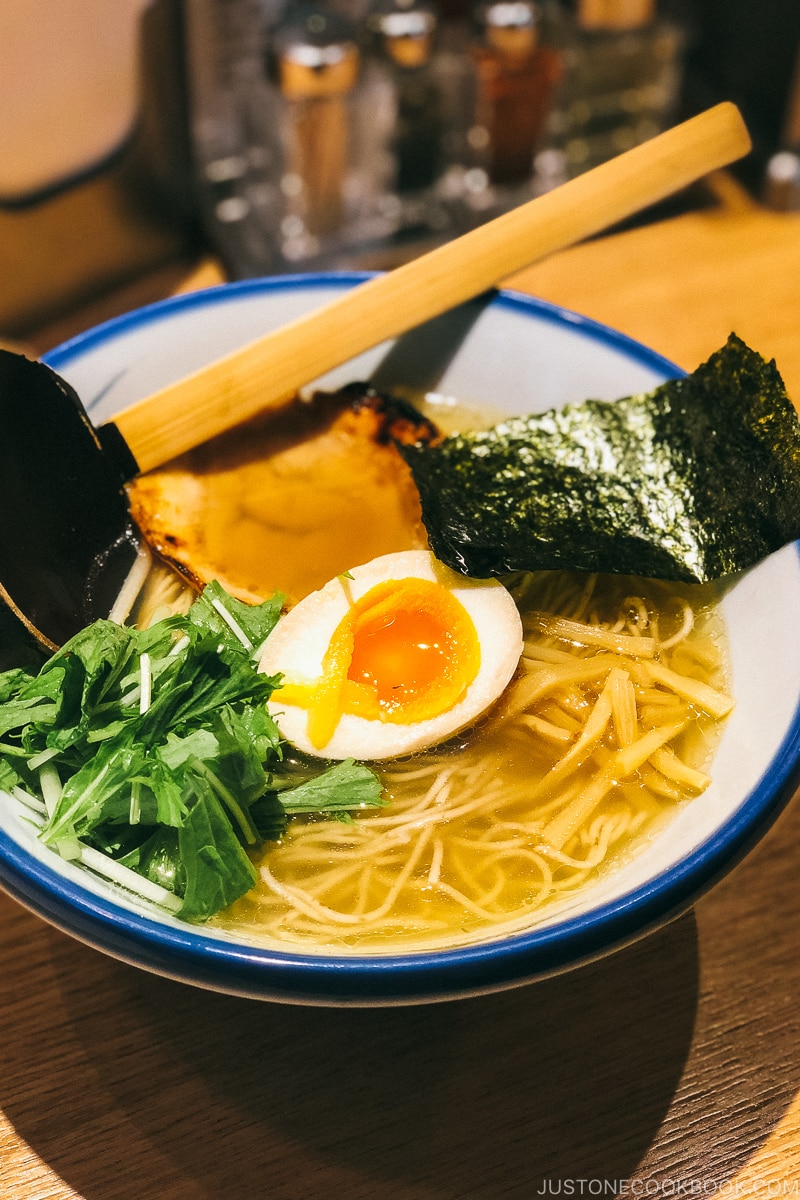
Hello, ramen fans! How many types of ramen have you tried? And what are some of your favorite bowls?
One would need to spend a lifetime trying out all the different styles of ramen available in Japan. Each ramen—defined by regional styles and specialties—abounds with soup stocks, noodles, and toppings, all varied based on local ingredients, tastes, and cultures. Even outside of Japan, the burgeoning of ramen has brought a severe ramen boom culture across the globe, expanding the realm of ramen beyond the traditional bowls.
While there’s an infinite world of ramen, we are here to demystify the different types of ramen you’ll want to know. Ready for your ramen adventure? Let’s dive straight into this Japanese ramen guide.
Table of Contents
What is Ramen?
Ramen is a Japanese adaptation of the Chinese noodle dish called lamian (拉麺), and it consists of long wheat noodles served in a soup broth with a variety of toppings. Meaning ‘pulled noodles,’ multiple etymologies are associated with ramen, and the classic ramen concept has significantly evolved and is still today.
Origin of Ramen in Japan
There are several theories about the origin of ramen in Japan. According to the Shin-Yokohama Raumen Museum, ramen was introduced to Japan at the end of the Edo period by the influx of Chinese immigrants who settled in Yokohama, Kobe, Nagasaki, and Hakodate. The expansion of Chinatowns (also called Nanjing towns) in these port cities opened a floodgate for Chinese cuisine that is to become a distinct part of Japanese food culture, known as chuka ryori.
In 1910, the first ramen shop Raitaiken (来々軒), was opened in Akasusa, Tokyo. The main menu was “Nankin soba,” named after Chinatowns and soba noodles. These noodle dishes spurred the popularity of ramen throughout Japan that ramen critic Hiroshi Osaki calls this year “the first year of ramen.”
Following the success of Raitaiken, more Chinese restaurants opened up, and ramen became a standard menu along with dishes like dumplings, fried rice, and shumai. Over the years, ramen has developed and transformed into a uniquely Japanese noodle dish.
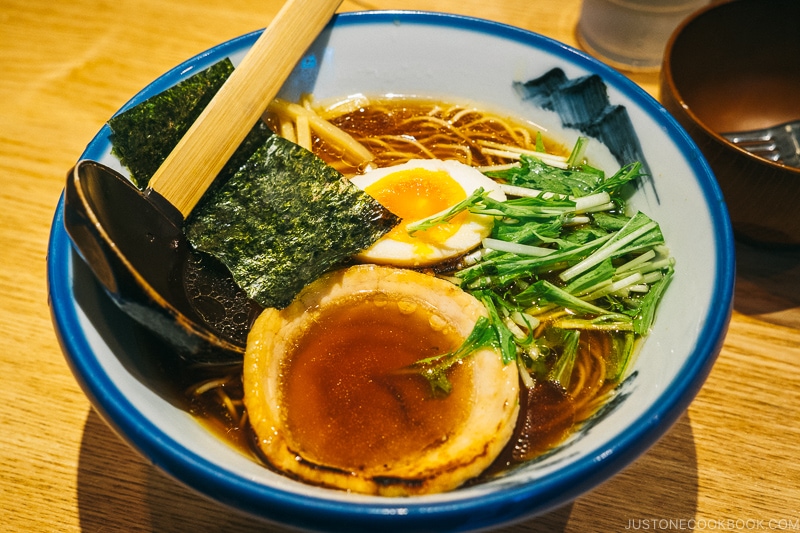
Ramen Today
Today, ramen is not only the soul food of Japan, but its popularity also spans the globe as one of the most influential foods internationally.
The ramen craze phenomenon partly has to be credited to inventor Momofuku Ando, who solidified ramen’s reputation by developing the world’s first instant ramen, “Chicken Ramen” in 1958. By the late 20th century, instant noodles had spread worldwide, and big Japanese ramen chains, such as Ippudo and Ichiran started to expand globally and pushed the standard of quality Japanese ramen.
Since then, the noodle dish has come in many forms, from the cheap fast food in a cup to the Michelin options. In Japan alone, you can find over 32,000 ramen shops, countless hidden behind train stations and department buildings, or tucked in inconspicuous alleyways. While in the U.S., we have David Chang and Ivan Orkin, who popularize ramen with their endeavors.
Ramen shops in Japan are simple eat-and-go restaurants, not a place to linger long after your meal. It’s usually counter seating, where you buy a meal ticket at the entrance and hand it to the staff.
What Goes into Ramen
Before we get to the ramen types, let us first take a quick look at what makes up a bowl of ramen:
Soup
As one would expect, soup is the elemental factor that determines the greatness of a bowl of ramen. Ramen masters put a great deal of effort into concocting their soup.
a) Soup Broth
The soup broth is the base and is made from umami-rich ingredients such as pork or chicken bones, dried seaweed, seafood, charred vegetables, lard and fats, and aromatics.
b) Tare (Sauce)
Tare, or the sauce, defines the critical flavor of ramen. There are three primary tare: miso, salt, and soy sauce, and they can be combined with other seasonings such as mirin, sake, sugar, spices, or bean paste to create a rich sauce that will complete the soup broth.
Noodles
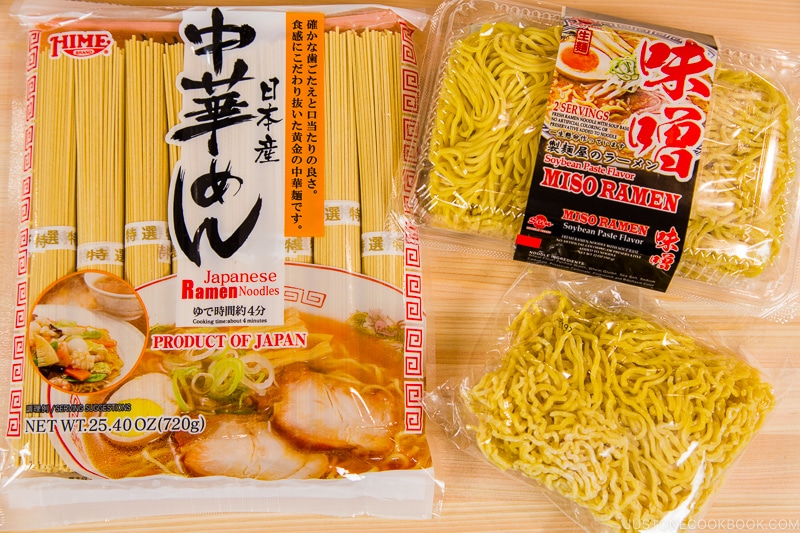
Another major component of ramen is noodles. Ramen noodles, also called soba (not to be confused with buckwheat soba), are made of wheat flour, salt, water, and kansui. Kansui, an alkaline solution, gives ramen its distinct yellow tint and springy texture.
The noodles can be straight, wavy, or of varying thickness. Pay attention to the ramen packaging, and you’ll spot numbers like no. 18, 20, 22, 24, 26, and 28, which tells you the noodle cut.
Toppings
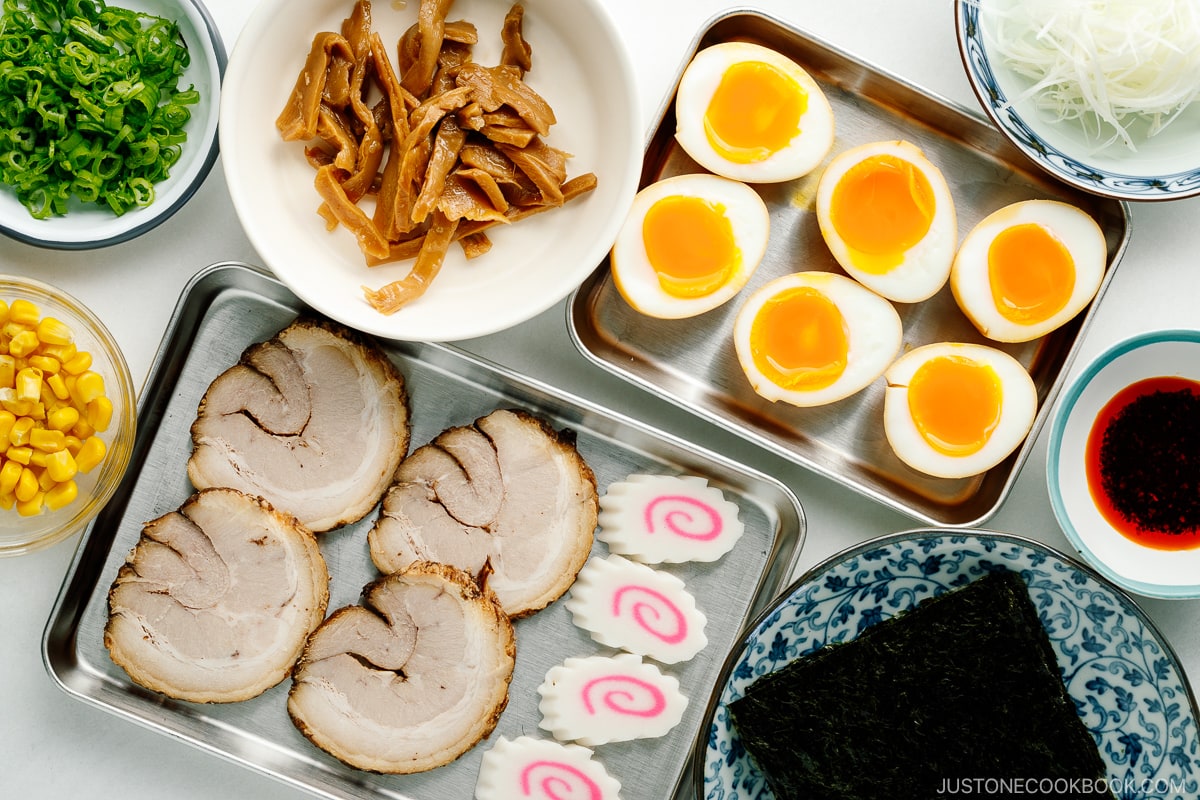
The last component is toppings. The options are endless, but the standards are tender chashu slices (simmered pork belly or pork shoulder), soft-boiled eggs, AKA ramen eggs, menma (bamboo shoots), nori sheet, bean sprouts, narutomaki fish cake or kamaboko, and negi scallions. Lastly, you can sprinkle sesame seeds, shichimi togarashi, la-yu chili oil, or grated garlic or ginger for an extra punch of flavor.
The combination of ingredients sometimes defines a unique style of ramen, and there is no-frills ramen that doesn’t come with toppings.
Read: Best Toppings to go with Your Homemade Ramen
3 Main Types of Ramen: By Tare
When you go to a ramen shop or ramen-ya in Japan, you’ll often see ramen being categorized by the type of tare used in a particular bowl. The three primary tare flavors are shio (salt, 塩), shoyu (soy sauce, 醤油), and Miso (fermented soybean paste, 味噌). These are the building blocks to develop different styles of ramen.
1. Shio Ramen 塩ラーメン
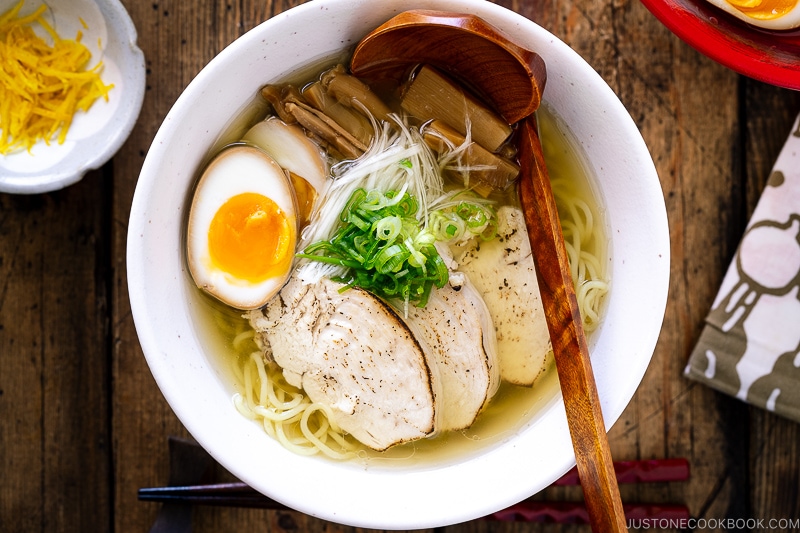
Shio means salt, so shio ramen is seasoned simply with salt tare. The soup is clear, delicate, and light as it is simmered more slowly to concentrate the flavor and prevent cloudiness. The broth is often made with chicken broth (sometimes with the addition of pork bones) and flavored with dried sardines, dashi stock, bonito flakes, seaweed, and vegetables.
Light-colored to the point of almost translucent, shio ramen is salt-based ramen broth. It’s also the lightest in terms of oil as it is boiled down to concentrate the flavor. Ramen shops would then dress the broth with chicken, seafood, seaweed, and pork bones.
🍜 Get our Shio Ramen recipe!
2. Shoyu Ramen 醤油ラーメン
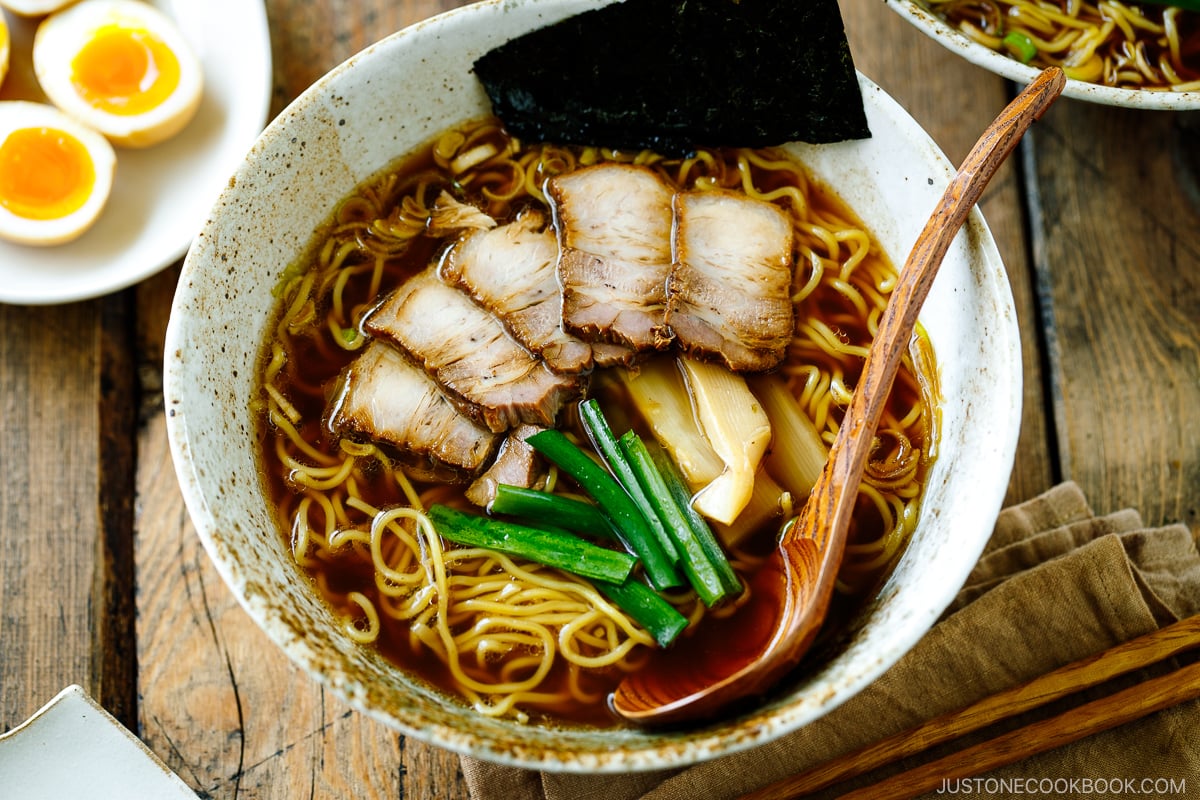
Seasoned with Japanese soy sauce, shoyu ramen tastes slightly more complex than shio. The broth could partake a clear brown color that’s light on the tongue or a dark cloudy color that’s dense and rich, depending on what is additionally swirled into the broth.
Shoyu ramen— also called Tokyo Ramen —is the original Tokyo-style classic that reminds many of mom’s homemade ramen or that nondescript ramen shop from childhood.
🍜 We have two versions of shoyu ramen on the blog: Shoyu Ramen from Bizentei and Nami’s Spicy Shoyu Ramen.
3. Miso Ramen 味噌ラーメン
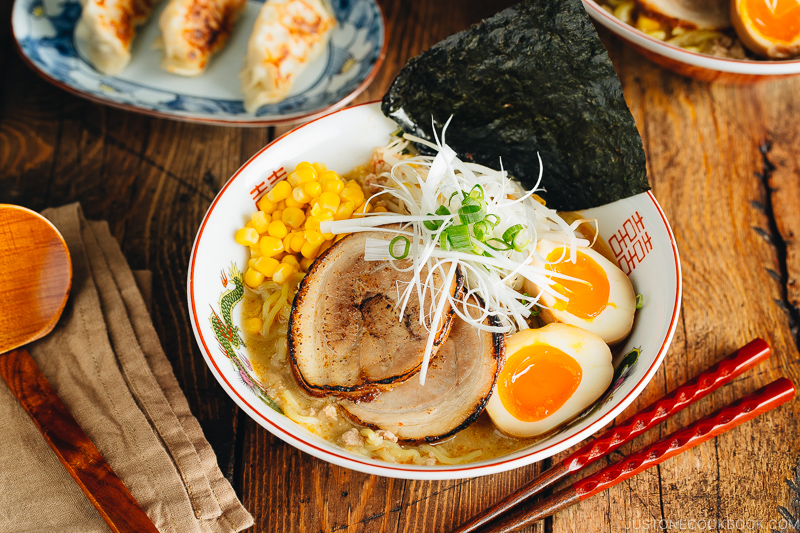
The most umami-rich of the three ramen and the heaviest, miso ramen is known for its deep richness and bold flavor. Miso ramen originates from the northern island of Hokkaido, but its popularity has spread across the country, where there are as many miso ramen broths as there is miso.
🍜 Get Nami’s Highly Rated Miso Ramen Recipe.
Wait, How About Tonkotsu Ramen and Tori Paitan?
Interestingly, tonkotsu ramen (豚骨ラーメン) has received such widespread popularity in the U.S. and other parts of the world that it is often classified as the fourth type of ramen. However, we want to clarify that tonkotsu is not tare but a type of soup broth, and it might surprise you that it has lost its popularity over the past decade in Japan.
Taking over the rank is tori paitan (鶏白湯), a thick and milky chicken-based soup broth. It’s especially among women who try to get extra collagen from the soup.
So, to be technically correct, we consider both tonkotsu ramen and tori paitan by soup categories instead of grouping them as the tare flavors. Let’s talk more about the soup categories.
Ramen Type by Soup Categories
Besides tare (sauce), Japanese ramen experts also classify ramen by the types of soup stock. Called “dashi” in the ramen language, the soup stock plays the core part of ramen. There are two types of soup stock: Chintan soup and Paitan soup.
1. Chintan Soup (清湯スープ)
Typical shoyu ramen, shio ramen, and miso ramen discussed above are made with this soup broth. Chintan soup is clear and thin and is made with bones of pork, chicken, or both, as well as vegetables and seafood. The soup stock is boiled down over low heat to prevent it from becoming cloudy, resulting in a clear soup.
Because of its light flavor, chintan soup is almost always made with traditional Japanese dashi ingredients. Combining the unique and umami-loaded flavors in dashi with pork or chicken soup broth will give you a real Japanese food experience. These umami-imparting ingredients are:
- Katsuobushi
- Dried anchovies (niboshi) and ago (pronounced ‘agoh’)
- Kombu
- Dried shiitake mushrooms
2. Paitan Soup (白湯スープ)
Tonkotsu ramen and tori paitan ramen are under this category. Paitan soup is creamy, thick, and made with pork bones (for tonkotsu) or chicken bones (for tori paitan). The soup stock is boiled over high heat for a long time (8-10 hours) until the bones are broken into pieces. Robust boiling on high heat will produce an emulsion, resulting in concentrated, thick, cloudy soup with rich umami flavors.
Tonkotsu Ramen 豚骨ラーメン
One of the richest tonkotsu ramen is a creamy, complex ramen made from pork bone broth. It is often regarded as the fourth type of ramen outside of Japan. However, it’s important to note that tonkotsu (meaning “pork bone”) is a soup broth and not a flavor.
According to Tokyo Ramen Tours, tonkotsu is said to be invented by mistake. A ramen chef in Fukuoka–a prefecture on Kyushu island—accidentally let his pork bones boil for hours more than intended. It resulted in a cloudy, fatty broth full of collagen and fantastic flavor. Everyone loved it, which gave birth to one of the most renowned ramen in the world.
Tori Paitan Ramen 鶏白ラーメン
Tori paitan ramen features chicken bone broth flavored with shio or shoyu. The near-white cloudy soup is made by simmering chicken bones and breast meat over high heat for a long time. It has a rich flavor but a lighter taste than tonkotsu soup broth.
*Note: Some ramen shops add salt or soy sauce tare to their tonkotsu or tori paitan, calling their menu Tonkotsu Shoyu Ramen, Tori Shio Paitan, Tori Paitan Shoyu Ramen, etc. Even though it includes “shoyu” in the menu name, the soup broth is milky and opaque, unlike typical shoyu ramen that’s dark brown and clear.
Ramen Type by Toppings
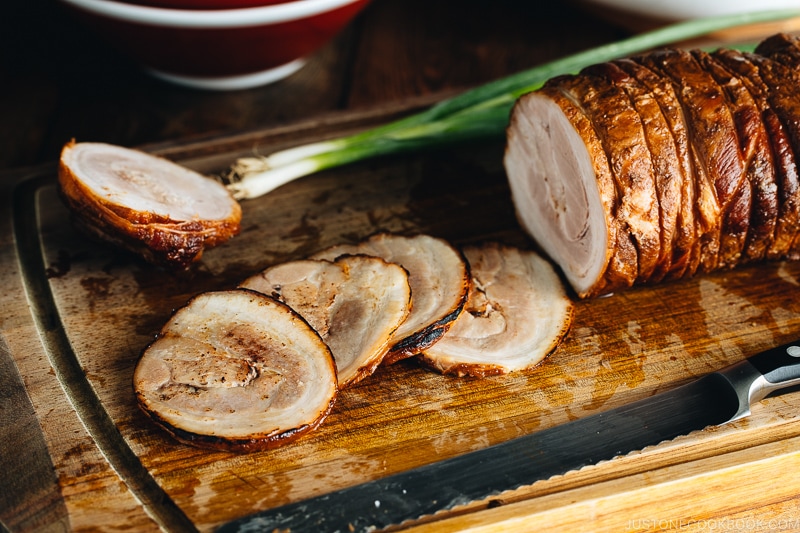
Another classification is by toppings. You can generally tell it by the name of ramen. It can be just one ingredient or a mix but it becomes the dish’s focal point.
Chashu Ramen チャーシュー麺
As the name implies, chashu ramen is all about the delicious sliced meat. Some ramen shops specialize in offering chashu—braised or grilled chicken or pork. As it is the main star of the ramen, you get extra slices in the bowl.
Negi Ramen ネギラーメン
Negi refers to green onions, and the traditional negi ramen is often covered by a green pile of sliced negi, with every slurp being a mix of soup, noodles, and green onion.
Wonton Men ワンタン麺
Seeking for more carbs in your bowl? Go for wonton men, ramen with slippery wonton.
Regional Variations
1. Hokkaido Ramen (Hokkaido)
Hokkaido has three popular regional ramen types that are well-known throughout Japan.
- Sapporo Ramen (Miso) – This regional specialty ramen is as famous as Sapporo beer, featuring curly medium-thick noodles with sliced meat, vegetables, and notably a pile of sweet corn and a big slab of butter. The hot soup broth can be flavored with soy sauce, salt, and miso, but the most popular flavor is the miso ramen. The rich and bold-tasting miso soup has a lot of lard that keeps it from getting cold.
- Asahikawa Ramen (Shoyu) – Complex and rich tasting, Asahikawa ramen is another famous ramen from Hokkaido. The soup stock—called the double soup— is made with a combination of animal bones, such as pork bones and dried sardines. You can see the fatty sheen on top of the soup as it keeps it warm for a longer time, which is excellent for long, cold days.
- Hakodate Ramen (Salt) – Hakodate’s salt ramen is characterized by its delicately light taste and low oil content. Hakodate is close to the sea, but almost no ramen shops use seafood in their soup stocks for some reason.
2. Kitakata Ramen (Fukushima)
Fun fact: Kitakata City in Fukushima Prefecture has one of the highest ratios of ramen shops to population in Japan. It is the staple food in the area, and many people would eat ramen for breakfast before heading to work.
The ramen is characterized by locally-made thick noodles with a high water content that uses the famous spring water. Because of its tasty noodles, the ramen bowls often come with a large portion of noodles.
3. Hakata Ramen (Kyushu)
Originating in Fukuoka, Hakata ramen is very similar to tonkotsu ramen. It features ultra-rich, milky white tonkotsu soup broth with thinner noodles and minimal toppings. Hakata ramen can include tare sauce like miso, shio, or shoyu, but it’s left plain to spotlight the robust broth.
Hakata ramen is what most people think of when they hear pork bone ramen, and it is one of the most famous local ramen in Japan. Since the noodles are skinny and stretchy, most restaurants serve only a tiny portion to prevent the noodles from becoming soggy.
If you crave more, instead of ordering another bowl, ask for refill noodles by saying ‘kae-dama kudasai,’ (替玉), which means ‘more noodles, please.’ The ramen chef will directly serve another portion of noodles in your finished bowl. You might be able to find Hakata ramen internationally as the Ippudo ramen shop offers it on its global menu.
Ramen Deviations
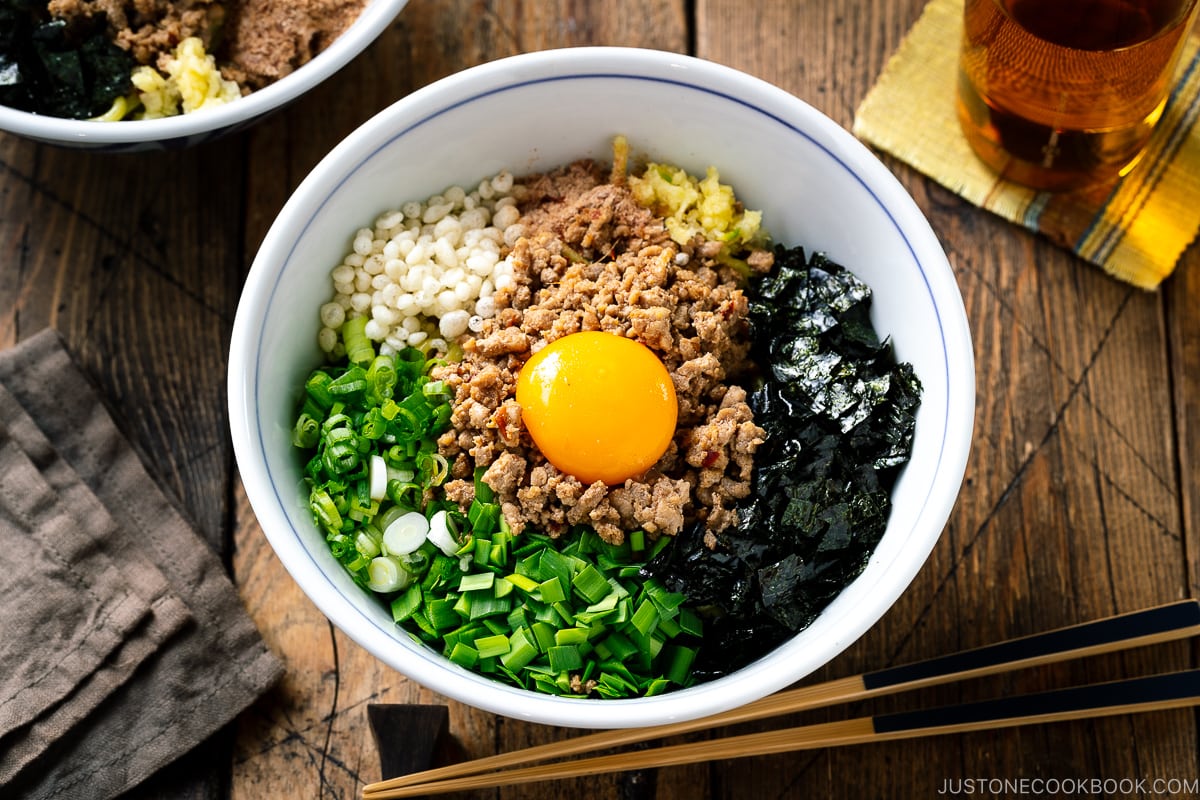
Now, we come to a completely different league of ramen that doesn’t fit into the above categories. They have unique features and characters, such as Tsukemen, Mazesoba (Mazemen), Okinawa soba, and Abura soba. Some dishes use the wavy noodles in different forms, such as yakisoba and hiyashu chuka, which is another story.
Some ramen shops expand their repertoire to include gluten-free, halal, and vegan ramen. While not commonplace, ramen masters are taking note of the changing demands of their hungry customers.
Did You Enjoy this Japanese Ramen Guide?
We hope this Japanese ramen guide has stirred your curiosity and your senses! Share with us your favorite style of ramen and local ramen shops in the comment box below.
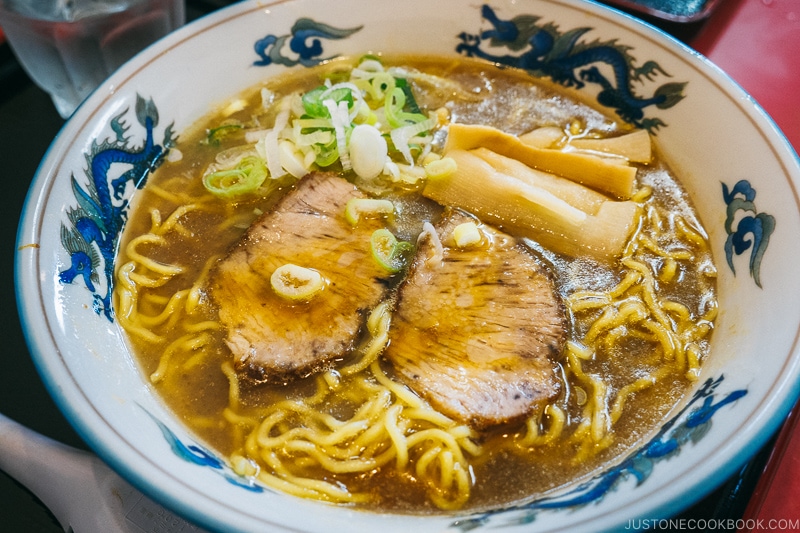





Loved the Ramen guide!
Even my daughter Roma who lived in Tokyo once, won’t know about that many types!
As an oldie, I don’t have evening meals but a bowl of Miso or broth. Ramen is great for the hungrier nights in winter. Thank you for your great recipes!
Hello Tania! We are glad to hear you enjoyed reading it.
We hope you will enjoy Nami’s homemade ramen soon! Happy Cooking!
I’m a little sad there’s no tonkotsu recipe on JOC, as this is my go-to website for authentic Japanese, but I loved learning about the different types of ramen that exist. Perhaps some time in the future you guys will have cooked up a delicious tonkotsu recipe for me to try.
Hi Jay! Maybe one day. Thank you for letting me know your interest. It takes a really long time to make it (at least 2 days for home level?) and Tonkotsu is not a common homemade ramen stock that home cooks make and we usually go out to eat tonkotsu ramen… as opposed to shoyu or miso are way more do-able for home cooks. It’s been on my list for quite some time. I’ll get to it one day!
Not long ago, we started cooking “fake ramen” at home, and we’re dying to try the real deal. That’s why we’ll take a tour of our city to find a Japanese restaurant that serves ramen. We’re grateful for your intake of different types of ramen classified by their type of tare flavors.
Hi Eli, thanks for reading 🙂 I hope your food tour is fruitful! Good luck with the hunt for great ramen!
Close to me there is a restaurant called Issho Ni Ramen in Willoughby, Ohio. They are how I found out about tori paitan. They have it in their Kiiro ramen. They also have Kuro Ramen which uses squid ink and black garlic oil. They try to source a lot of their ingredients from Japan. It’s my favorite spot for Japanese.
Hi Kelly! Thanks for reading and sharing your ramen experience in your hometown 🙂
Another one for you to try when you head back to Tokyo: Ramen Shokudo Iki na Issho in Akihabara. It was divine.
Hello, Janine! We apologize for the delay in responding!
Thank you so much for reading Kayoko’s post and providing the location!😊
Requesting a recipe for tonkotsu broth (stock pot style or instant pot style)! There seems to be a gap in the available recipes online even though it’s arguably one of the more popular types of broth!
Hi Bolo Bao, thanks for your request! In Japan, no one makes tonkotsu broth at home because there are so many ramen places around and it takes quite a lot of skills and mastery to perfect it (hence ramen shops specializing in tonkotsu).
What would ramen with rice noodles be called, out of curiosity? I make it with all the same ingredients but have to use rice noodles because I have celiac.
Hi Randi! I don’t think there’s a technical word for ramen made with non-ramen noodles. There are some ramen shops that offer gluten-free options. I think it’s perfectly fine to call it ramen!
I had a “White Miso Ramen” at a ramen shop in Okinawa over 10 years ago. It was my favorite dish I had when I visited and have wanted to try to recreate it. I’m pretty sure from my searches, the shop was called Hayate Maru in American Village in Okinawa. In my searches, it’s described as a “northern style Japanese ramen shop” Any insights or tips on how I could go about recreating this dish? I would love to have it again and make it for my husband! Thanks!
Hi Jaylyn, thanks for your comment. I did a quick check on google, seems like this is a Hokkaido (northern Japan) style ramen, but they set up shop in the most southern part of Japan. Interesting! Their white miso ramen seems like a store specialty, but have you tried making Nami’s Miso Ramen? She also has a vegetarian ramen, which is miso and soy milk-based. Please do give it a go!
Wow, this is a whole new life! I’ll never get out of the kitchen! A few years ago I ate with Osamu Tomita as discovered a total revelation grand cuisine. I’ll get started with some of your recipes as soon as possible. Why didn’t you mention a Tomita Ramen restaurant in Matsudo? “RamenHeads” the documentary.
Hi Foster, thanks for reading 🙂 Yes, I’ve watched the “Ramen Heads” documentary. I haven’t been to his shop in Matsudo because the lines seem too crazy to me, but have eaten at his satellite shop in Tokyo station. This post came out in Fall 2017, before the documentary premiered in 2018. Good luck with your ramen cooking!
This is so helpful, thank you!! I moved back from Japan to a small town in the US a few years ago and really miss the food. One place that always comes to mind is a Tantanmen shop in Shibuya – if you use the south exit and cross over the footbridge in the direction of Ebisu (along the JR line) it was at the bottom of the set of steps that face the tracks. From Google Maps it looks like that whole block may have been demolished now but I’m not sure. Anyhow, it was one of my favorites. Have you eaten there? (Sorry for not having the name)
Hi Jake, thanks for reading! Unfortunately, I don’t think your tantanmen shop in Shibuya exists anymore, that area around the Shibuya-Ebisu JR line went through a huge renovation project and the quaint shops along the train tracks got demolished in the process 🙁 I have not eaten there, but glad that it was memorable for you!
Thank you so much for these information, I love ramen! I even had a bowl at Shinsekai, Osaka and it blew me off the scale. I will always be a fan of ramen.
Hi Dennis! Glad you found this informative! Hope you’ll be back here soon to dig into more bowls of ramen 🙂
こんにちわ、佳代子さん! When I started to read this ramen guide, I knew I had to leave a comment. Before I moved to the US a year ago, my husband and I were living in Shanghai China. We were crazy about a Hong Kong ramen noodle chain called 豚王. We just loved the rich flavored Tonkotsu ramen. One time we were in Okinawa for three weeks, man, just imagine all the noodles we had. Truly soul food!
こんにちは、サラさん!Ramen is soul food, and the best part being that there are so many different varieties to choose from! Personally, as I’ve grown older (and my digestive system also aging) I’m a fan of lighter broths like shoyu and shio but do occasionally dig into a rich tonkotsu ramen. Thanks for reading! 加代子
Your post about ramekins great, 10 stars. However, I’m not a big fan of your new website. I long for the old JOC site. 🙁
Hi Michael, thank you for reading and for your feedback on the new site.
Ahh RAMEN!! I can’t get enough of it! We, our family of 4 with kids under 10yo, are planning on visiting Japan (Don’t know when but we will) and what we want to do is eat in a hole in the wall ramen shops. Thanks for your list of ramen shops!!!
Hi Ivy! There are plenty of hole in the wall ramen shops awaiting your hungry family’s arrival! Thanks for reading 🙂
Hi Nami,
You are an amazing writer and cook!
I read your post about “dashi” and I have been using the techniques and also the ready-to-go dashi powders in my cooking.
I was wondering if there is a “pork powder” that we can use to make tonkotsu ramen instead of all the work to make it from scratch…
Thank you!
Hello Priscila, this is Kayoko, author of this post. Thank you for your kind words, I have passed it on to Nami!
I don’t have any experience making tonkotsu ramen at home as I can easily grab a bowl here in Japan, and don’t have any personal recommendations on brands. You might have better luck hunting around Asian supermarkets for pork noodle soup packets, although I can’t guarantee the flavor would be the same. Please let me know if you find any success, and good luck with your search!